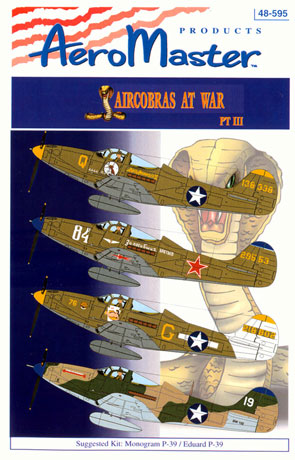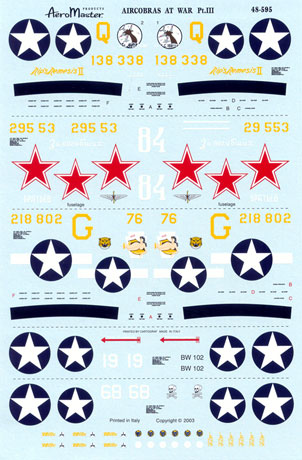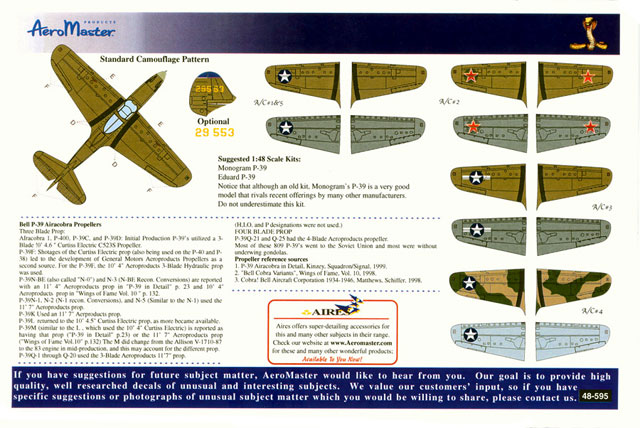|
 Airacobras
at War Airacobras
at War
Part III
AeroMaster
Decals
|
S u m m a r y
|
| Catalogue
Number: |
AMD 48-595 - Airacobras at
War Part III |
| Scale: |
1/48 |
| Contents and Media: |
Waterslide decals plus instructions and notes |
| Price: |
USD$10.00
from Aeromaster website |
| Review Type: |
FirstLook |
| Advantages: |
Sufficient national markings for all
five subjects and stencil data for two; perfect register; thin; minimal carrier film;
comprehensive stencil data; good instructions with top, bottom and
plan views; good donor kit available (Eduard) |
| Disadvantages: |
|
| Recommendation: |
Recommended |
Reviewed
by Rodger Kelly

HyperScale is proudly sponsored by
Squadron.com
|
Judging by the steady stream of
Airacobra sheets, someone at AeroMaster must
like the P-39! Aeromaster 48-595 provides markings for five aircraft,
four of them USAAF machines and a single Russian VVS example.
First is 41-38338, a P-39D of the
36th Fighter squadron (FS), 8th Fighter Group (FG)
based at Port Moresby New Guinea in 1942. The aircraft is named “Nip’s
Nemesis II” and was flown by Lieutenant Don “Fibber” McGee.
 The
aircraft is in the standard olive drab over neutral grey scheme worn by
P-39s with a yellow fin tip and spinner. The markings consist of: The
aircraft is in the standard olive drab over neutral grey scheme worn by
P-39s with a yellow fin tip and spinner. The markings consist of:
- “Door art” of a hand and arm
clutching a Japanese aircraft.
- Yellow serial number, “Nip’s
Nemesis II” titles, and individual aircraft letter “Q”.
- White four aircraft kill
markings.
The second aircraft is the Russian
VVS machine a P-39N, 42-9553. It was flown by Major Mikhail Rents of 30
GIAP in the skies of Germany in the spring of 1945.
Camouflage is the olive drab over
neutral with a blue fin tip (with a thin white band which is supplied as a
decal) between the blue and the olive drab) and spinner. The markings
consist of:
- Yellow serial number for the
fin.
- White 84 “Bort” numbers.
- White patriotic slogan which
translates to “for my perished brothers”.
- Soviet aviator’s wings for both
doors.
Next is another P-39N, serial
number 42-8802 as flown by Lieutenant Roy Own of the 41st FS,
35th FG from Nadzab, New Guinea in October of 1943.
The aircraft is in pained olive
drab over neutral grey with a yellow fin tip and spinner. It also wears
the white-tailed theatre markings. The individual markings consist of:
- Yellow serial numbers,
individual aircraft letter G, and “plane in squadron number” 76.
- “Door art” consisting of the
seemingly obligatory nude female.
- Nose art of a tiger’s head.
The fourth aircraft is an early
P-400, serial number BW 102. The aircraft belonged to the 39th
FS, 35th FG and was flown by Lieutenant Curran Jones from one
of the many rough strips that surrounded Port Moresby.
This option is finished in the
“sand and spinach with light blue under surfaces” scheme with a blue fin
tip and spinner.
Markings are sparse but consist
of:
- White plane-in-squadron number
19.
- Nose art in the form of a red
arrow with script “THE FLAMING” painted above it.
- Black BW-102 serial number.
The final aircraft is another
P-39N as flown by Lieutenant Bill Fiedler of 68th and 70th
FS, 347th FG out of Guadalcanal in June of 1943. The serial
number is not known.
A real plain Jane this one! It is
finished in Olive drab over neutral grey and its markings consist of:
- White plane-in-squadron number
68.
- White skull and crossbones.
The appropriate national insignia
is provided for each aircraft – a set for each one, and enough stencil
data including wing-walks, for two aircraft. An individual data block is
also supplied for each aircraft with the appropriate serial number.
Curiously, the data block for the last option reads 42-18801.
There are
also sufficient propeller stencils provided for two of each type of
aircraft fitted with the appropriate propeller. To help you with this,
the placement guide gives a very comprehensive discourse on which
propeller (Aeroproducts or Curtiss Electric) was fitted to what model
P-39.
Decal placement is guided by a
full-colour double sided A-4 sized sheet. As well as showing decal
placement it also provides a comprehensive list of references.

The decals themselves have been
printed by Cartograf. They are all sharp, clear and in perfect register
with minimal decal film.
As per standard Aero Master
practice, the placement guide and decal sheets are packed in a clear
plastic zip-loc bag.
The recommended kits are Eduard
and Monogram.
This is a very nice sheet from
Aeromaster.
Recommended.
Thanks to AeroMaster
/ Eagle Strike
Products for the review sets
On-line sales are available from the
AeroMaster Products /
Eagle Strike Productions web site.
Review TextCopyright © 2003 by
Rodger Kelly
This Page Created on 25 May, 2003
Last updated
14 August, 2003
Back to
HyperScale Main Page |
Home | What's
New | Features
| Gallery |
Reviews | Reference
| Forum
| Search